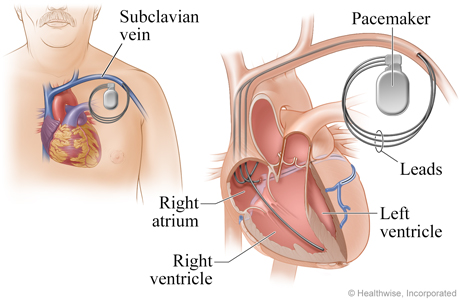Our Health Library information does not replace the advice of a doctor. Please be advised that this information is made available to assist our patients to learn more about their health. Our providers may not see and/or treat all topics found herein.
Biventricular pacemaker for heart failure (cardiac resynchronization therapy)

A pacemaker for heart failure, used for cardiac resynchronization therapy (CRT), sends electrical pulses to the heart to keep the lower chambers (the ventricles) pumping together. This type of pacemaker is also called a biventricular pacemaker.
A doctor places the pacemaker in the chest. The pacemaker has three wires, or leads, that connect to the heart through the subclavian vein. One lead is in the right atrium (upper chamber). A second lead is in the right ventricle. The third lead is in a vein on the outside of the left ventricle. This vein is called the coronary sinus branch vessel.
Current as of: July 31, 2024
Author: Ignite Healthwise, LLC Staff
Clinical Review Board
All Healthwise education is reviewed by a team that includes physicians, nurses, advanced practitioners, registered dieticians, and other healthcare professionals.
This information does not replace the advice of a doctor. Ignite Healthwise, LLC disclaims any warranty or liability for your use of this information. Your use of this information means that you agree to the Terms of Use and Privacy Policy. Learn how we develop our content.
To learn more about Ignite Healthwise, LLC, visit webmdignite.com.
© 2024 Ignite Healthwise, LLC. Healthwise, Healthwise for every health decision, and the Healthwise logo are trademarks of Ignite Healthwise, LLC.



